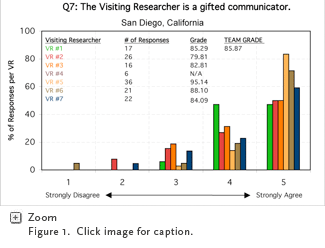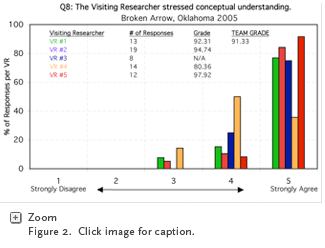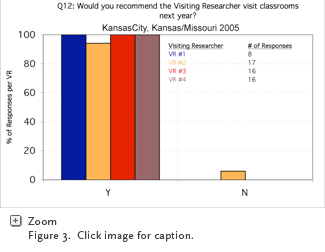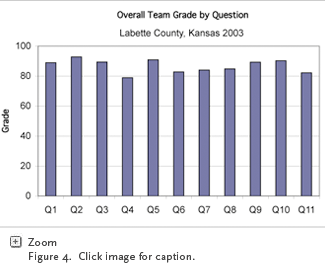|
 |
 |
 Fundamental
objectives for the Classroom Visit presentation: Fundamental
objectives for the Classroom Visit presentation:
- The Visiting Researcher must operate outside of ‘lecture
mode’ and engage audiences through audience participation.
- The Visiting Researcher must make science concepts, general
content, and the process of science understandable by building
bridges to the familiar (using vocabulary and experiences
that are familiar to the students.)
- The Visiting Researcher is to design presentations that
relate to their research—their personal story—and
that connect to the curriculum through relevant grade K-12
national science education standards.
- The Visiting Researcher is to provide an understanding
of their personal career path, and more generally, the subjects
and disciplines of importance to students interested in
a research career.
|
 |
 The
Classroom Visit component of the Journey through the Universe
program is currently assessed using a third-generation
questionnaire. The questionnaire assesses the Classroom Visit
presentation based on audience response, content, and presentation
style. The questionnaire is filled out by hopefully all educators
who were present during a Classroom Visit by a Visiting Researcher.
The questionnaires are handed out to the educators in self-addressed,
stamped envelopes. It is the responsibility of the participating
school districts to ensure educators complete and submit their
questionnaires to the National Center for Earth and Space
Science Education. The
Classroom Visit component of the Journey through the Universe
program is currently assessed using a third-generation
questionnaire. The questionnaire assesses the Classroom Visit
presentation based on audience response, content, and presentation
style. The questionnaire is filled out by hopefully all educators
who were present during a Classroom Visit by a Visiting Researcher.
The questionnaires are handed out to the educators in self-addressed,
stamped envelopes. It is the responsibility of the participating
school districts to ensure educators complete and submit their
questionnaires to the National Center for Earth and Space
Science Education.
Download
Classroom Visit Questionnaire (PDF, 130 KB)
On receipt of the questionnaires, all quantitative data and
all comments are entered into a database and a Classroom Visit
assessment report is generated. Samples of the quantitative
analysis portion of the report are provided in graphical format
at the bottom of this page. |
| |
 |
The questionnaire asks the respondent to rank the efficacy
of the presenter on a 1 to 5 scale for 11 quantitative questions
(see below.) A ranking of 1 through 5 for each question is
equivalent to the following assignments: 5-very good; 4-good;
3-fair; 2-poor; 1-very poor. There are also a significant
number of comment fields on the questionnaire, including questions
that only ask for comments.
- (Q1) The Visiting Researcher’s Presentation involved
audience participation.
- (Q2) The Visiting Research used age-appropriate vocabulary
during his/her presentation.
- (Q3) The students responded positively to the Visiting
Researcher’s presentation.
- (Q4) The presentation was relevant to my curriculum.
- (Q5) The Visiting Research told students about her/himself
and the research she/he conducts.
- (Q6) The Visiting Researcher’s personal story was
interesting to the students.
- (Q7) The Visiting Researcher is a gifted communicator.
See Figure
1.

- (Q8) The Visiting Researcher stressed conceptual understanding.
See Figure
2.
- (Q9) The Visiting Researcher related the unfamiliar to
the familiar using, for example, models.
- (Q10) The Visiting Researcher made effective use of visuals
and/or materials during the Presentation.
- (Q11) The Visiting Researcher provided students with
an awareness of the skills and qualifications required to
pursue a career in the scientific fields.
Each of the 11 quantitative questions is associated with
a graph that contains plots for all the presenters. See Figure
1 and Figure
2 as examples. For each presenter the graph includes the
presenter's name, the number of responses received for that
question, and an average grade on a 0 to 100 scale. The grades
are assigned using the following table: |
| |
Ranking
5 (very good)
4 (good)
3 (fair)
2 (poor)
1 (very poor) |
 |
Grade Assignment
100
75
50
25
0 |
 |
|
| |
This implies that if all the respondents assigned
a 4 out of 5 to a presenter, corresponding to ‘good’,
the presenter’s grade would only be a 75. The grading
is harsh, but the expectations from the community and the
program team are great. In general, we expect grades of
80 or better. Note that a grade is assigned
only if 10 or more responses to the question were received.
Also note that a Team Grade is provided, which is the average
grade over the Team.
Each graph is a series of plots, one for each presenter.
Each plot provides the percent of responses garnered by the
presenter in each of the rankings. The shape of each presenter's
plot is therefore a direct reflection of his/her average grade.
The higher the grade the greater the profile is skewed to
the right. |
| |
 |
As an overall gauge of the Visiting Researcher’s
success, the respondent is asked if they would recommend the
Visiting Researcher visit classrooms next year. Figure
3 provides a typical result, which speaks to the caliber
of the researchers. |
| |
 |
 The
assessment report includes a graph that provides the average
grade across the Visiting Researcher Team for each quantitative
question. This graph provides an overview of the Journey
through the Universe Classroom Visit program component,
and allows quick determination if the team made ‘the
grade 80 or higher’ mark in all areas being assessed.
Figure 4
provides a typical result. The
assessment report includes a graph that provides the average
grade across the Visiting Researcher Team for each quantitative
question. This graph provides an overview of the Journey
through the Universe Classroom Visit program component,
and allows quick determination if the team made ‘the
grade 80 or higher’ mark in all areas being assessed.
Figure 4
provides a typical result.
Download Sample Classroom Visit Assessment Reports
Kansas
City, Kansas/Missouri, 2005 (PDF, 65 KB)
Broken Arrow, Oklahoma, 2005 (PDF, 70 KB)
Moscow, Idaho, 2001 (PDF, 65 KB) |
|
|
